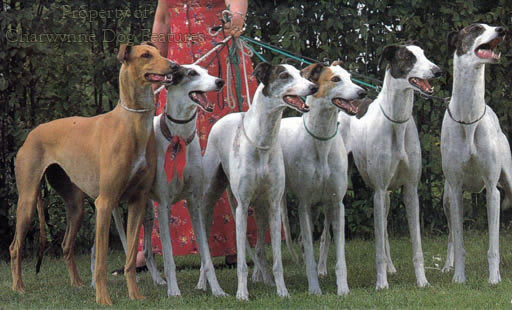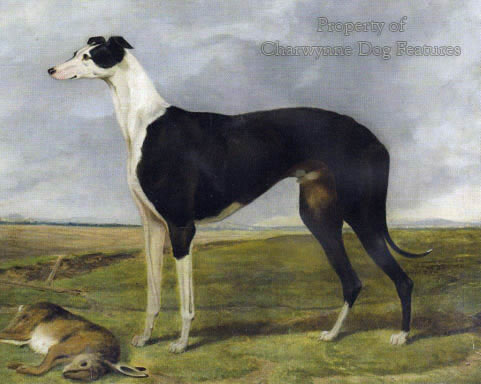810 THE GRACEFUL GREYHOUND
THE GRACEFUL GREYHOUND
by David Hancock
 With so few show Greyhounds being bred, with coursing at an end and with greyhound racing as a sport in comparative decline, it is not easy to measure how sound the pure-bred Greyhound is. When working in Ireland I regularly saw sporting Greyhounds that made you gasp with admiration. I still see the odd Greyhound-based lurcher that is strikingly impressive. But when visiting rescue kennels I am conscious of just how many ex-racing Greyhounds and Greyhound-type lurchers are there for rehoming. In the show ring, over the last three decades, I have only seen the occasional exhibit that impressed and their breeding base is now quite small. It is sad however to see a lack of muscular condition in show Greyhounds and at times a narrow-chestedness that must affect function in a sight-hound. Sporting breeds must still be judged in any venue on their ability to carry out their specific historic function, if not then there is really little point in breeding them. Breed points have no value if a breed loses its innate ability to perform. Sporting breeds came to us from a defined function; the essential ethos running through a breed, its breed clubs and its fanciers, is surely that of keeping faith with its functional design, rooted in purpose.
With so few show Greyhounds being bred, with coursing at an end and with greyhound racing as a sport in comparative decline, it is not easy to measure how sound the pure-bred Greyhound is. When working in Ireland I regularly saw sporting Greyhounds that made you gasp with admiration. I still see the odd Greyhound-based lurcher that is strikingly impressive. But when visiting rescue kennels I am conscious of just how many ex-racing Greyhounds and Greyhound-type lurchers are there for rehoming. In the show ring, over the last three decades, I have only seen the occasional exhibit that impressed and their breeding base is now quite small. It is sad however to see a lack of muscular condition in show Greyhounds and at times a narrow-chestedness that must affect function in a sight-hound. Sporting breeds must still be judged in any venue on their ability to carry out their specific historic function, if not then there is really little point in breeding them. Breed points have no value if a breed loses its innate ability to perform. Sporting breeds came to us from a defined function; the essential ethos running through a breed, its breed clubs and its fanciers, is surely that of keeping faith with its functional design, rooted in purpose.
Show Greyhounds display an appealing gracefulness. The harder-headed racing Greyhound community is not short of good-looking dogs, despite the over-riding priority given to track success. There are however concerns about some aspects of this industry: the high number of dogs abandoned to the rescue system and the harsh penalties to so many dogs of bend racing. Hard surfaces and the heavier dogs on today's tracks combine to increase the threat of serious injuries to Greyhounds when racing round bends. Research by Sweeney in 1980 demonstrated that over the years, by the time the Greyhound Derby Final is run each year, at least 40 of the entries will have sustained injury. I suspect that the heavier dogs receive the highest injury rate. Despite their relative freedom from hip dysplasia and cruciate ligament problems, Greyhounds have very vulnerable limbs, especially over unyielding surfaces. Expecting them to cope with unsympathetic race-track surfaces and carry considerable weight is not wise. For a disabled track Greyhound there is no future. I have different concerns about the show specimens.
A judge’s critique from a 2011 Greyhound Club conformation show, after stating that many of the entry were carrying too much weight, that affected movement and the elegance the breed should have, went on to comment: “I feel for the racing owners as they strongly support the breed at all levels; although all Greyhounds come from the same foundation stock, the racing dogs simply do not conform to the show standard (i.e. the written breed standard, DH) and are usually placed down the line…” In other words, dogs that are useful are less valued! In 1928, the Greyhound Primly Sceptre won Best-in-Show at Crufts, the first to win the new award. Racing Greyhounds have been regularly shown and entered for Crufts, perpetuating a long tradition. In 1929, the entry was 252 from 187 Greyhounds, of which only 17 were show bred, the coursing entry prevailing. Ernest Gocher’s brindle 70lb dog Endless Gossip is the most famous racing Greyhound to appear at Crufts; he won the 1952 Greyhound Derby and performed well at the 1953 Waterloo Cup. An outstanding show Greyhound, Treetops Golden Falcon, won Best-in-Show at Crufts in 1956, only the second member of the breed to win this supreme award. It is good to learn that Ireland’s annual Dublin show is to schedule special racing Greyhound classes, with each of the 22 tracks asked to send one dog to compete. At Crufts in 2009, in the racing/coursing entry, there was a striking black bitch Luvina Lexine Lacers Louise, which perfectly exemplified the correct conformation for the breed.
The show Greyhound fanciers might argue that they don't require their hounds to race. But that argument is countered by the wording of their breed standard. This is a breed clearly designed to run fast, very fast. The section under 'Gait/Movement' asks for a "Straight, low-reaching, free stride enabling the ground to be covered at great speed. Hind-legs coming well under body giving great propulsion." The need for a good slope to the pelvis to allow great forward extension in the hind-legs is not mentioned. Strangely, too, the characteristics of the breed are listed as: Possessing remarkable stamina and endurance. No mention of speed, the principal value of the breed to man down the ages and the whole purpose of its existence. The Greyhound is the supreme canine sprinter and hurdler. Our Greyhounds have been exported all over the world mainly because of their athletic excellence. If this hard-earned fame is to be retained, the show fraternity has a responsibility too, to respect those sportsmen in previous centuries who strove to develop for us this superlative sight-hound. It should be a joy rather than a burden to perpetuate this legacy.
